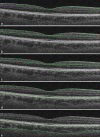The anterior and posterior biometric characteristics in primary angle-closure disease: Data based on anterior segment optical coherence tomography and swept-source optical coherence tomography
- PMID: 33727449
- PMCID: PMC8012975
- DOI: 10.4103/ijo.IJO_936_20
The anterior and posterior biometric characteristics in primary angle-closure disease: Data based on anterior segment optical coherence tomography and swept-source optical coherence tomography
Abstract
Purpose: Obtaining a better understanding of the pathogenesis of primary angle-closure disease (PACD) still requires studies that provide measurements of anterior and posterior biometric characteristics together and that assess the relationship between them.
Methods: In total, 201 eyes were enrolled in this cross-sectional study: 50 normal controls, 49 primary angle-closure suspect (PACS), 38 primary angle closure (PAC), and 64 primary angle-closure glaucoma (PACG) eyes. The anterior and posterior structural features were measured by anterior segment optical coherence tomography and swept-source optical coherence tomography.
Results: All PACD groups had smaller anterior chamber depth (ACD), anterior chamber area (ACA), anterior chamber volume (ACV), angle opening distance at 750 μm from the scleral spur (AOD750), trabecular-iris space area at 750 μm from the scleral spur (TISA750), and angle recess area (ARA), as well as a larger lens vault (LV), than controls (all P < 0.001). The PACS and PAC groups had thicker iris thickness at 750 μm from the scleral spur (IT750) than controls (P = 0.017 and P = 0.002, respectively). Choroidal thickness (CT) was not statistically different among normal, PACS, PAC, and PACG eyes. Univariate and multivariate linear regression analysis revealed a significant association between thinner IT750 and increased CT in PACD eyes (P = 0.031, univariate analysis; P = 0.008, multivariate analysis).
Conclusion: Thinner iris thickness was associated with increased CT in PACD eyes; however, the underlying mechanism needs further investigation.
Keywords: AS-OCT; SS-OCT; ocular biometry; primary angle-closure disease.
Conflict of interest statement
None
Figures
Similar articles
-
Anterior segment optical coherence tomography parameters in subtypes of primary angle closure.Invest Ophthalmol Vis Sci. 2013 Aug 7;54(8):5281-6. doi: 10.1167/iovs.13-12285. Invest Ophthalmol Vis Sci. 2013. PMID: 23788370
-
Analyzing Anatomical Factors Contributing to Angle Closure Based on Anterior Segment Optical Coherence Tomography Imaging.Curr Eye Res. 2022 Feb;47(2):256-261. doi: 10.1080/02713683.2021.1978098. Epub 2021 Sep 27. Curr Eye Res. 2022. PMID: 34569390
-
Comparison of Anterior Segment-Optical Coherence Tomography Parameters in Phacomorphic Angle Closure and Acute Angle Closure Eyes.Invest Ophthalmol Vis Sci. 2015 Dec;56(13):7611-7. doi: 10.1167/iovs.15-17336. Invest Ophthalmol Vis Sci. 2015. PMID: 26624492
-
Anterior Segment Optical Coherence Tomography: Is There a Clinical Role in the Management of Primary Angle Closure Disease?J Glaucoma. 2020 Jan;29(1):60-66. doi: 10.1097/IJG.0000000000001355. J Glaucoma. 2020. PMID: 31490798 Review.
-
Zonulopathy and Its Relation to Primary Angle Closure Disease: A Review.J Glaucoma. 2024 Dec 1;33(12):931-939. doi: 10.1097/IJG.0000000000002385. Epub 2024 Apr 5. J Glaucoma. 2024. PMID: 38573908 Review.
Cited by
-
Publication trends of primary angle-closure disease during 1991-2022: a bibliometric analysis.Int J Ophthalmol. 2023 May 18;16(5):800-810. doi: 10.18240/ijo.2023.05.19. eCollection 2023. Int J Ophthalmol. 2023. PMID: 37206181 Free PMC article.
-
Assessment of iris volume in glaucoma patients with type 2 diabetes mellitus by AS-OCT.Int J Ophthalmol. 2023 May 18;16(5):743-747. doi: 10.18240/ijo.2023.05.11. eCollection 2023. Int J Ophthalmol. 2023. PMID: 37206178 Free PMC article.
-
Imaging analysis of the biological parameters of the lens in patients with cortical age-related cataracts using ultrasound biomicroscopy.BMC Ophthalmol. 2023 Nov 22;23(1):480. doi: 10.1186/s12886-023-03227-2. BMC Ophthalmol. 2023. PMID: 37993828 Free PMC article.
-
Advances in swept-source optical coherence tomography and optical coherence tomography angiography.Adv Ophthalmol Pract Res. 2022 Nov 25;3(2):67-79. doi: 10.1016/j.aopr.2022.10.005. eCollection 2023 May-Jun. Adv Ophthalmol Pract Res. 2022. PMID: 37846376 Free PMC article. Review.
References
-
- Sihota R, Lakshmaiah NC, Agarwal HC, Pandey RM, Titiyal JS. Ocular parameters in the subgroups of angle closure glaucoma. Clin Experiment Ophthalmol. 2000;28:253–8. - PubMed
MeSH terms
LinkOut - more resources
Full Text Sources
Other Literature Sources
Research Materials


